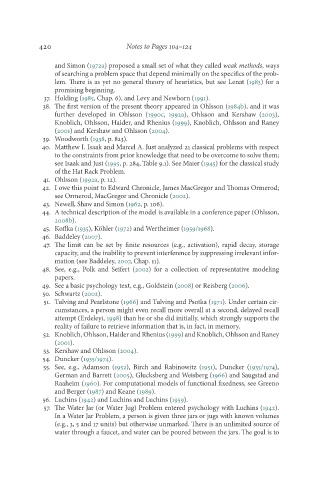Page 437 - Deep Learning
P. 437
420 Notes to Pages 104–124
and Simon (1972a) proposed a small set of what they called weak methods, ways
of searching a problem space that depend minimally on the specifics of the prob-
lem. There is as yet no general theory of heuristics, but see Lenat (1983) for a
promising beginning.
37. Holding (1985, Chap. 6), and Levy and Newborn (1991).
38. The first version of the present theory appeared in Ohlsson (1984b), and it was
further developed in Ohlsson (1990c, 1992a), Ohlsson and Kershaw (2003),
Knoblich, Ohlsson, Haider, and Rhenius (1999), Knoblich, Ohlsson and Raney
(2001) and Kershaw and Ohlsson (2004).
39. Woodworth (1938, p. 823).
40. Matthew I. Isaak and Marcel A. Just analyzed 21 classical problems with respect
to the constraints from prior knowledge that need to be overcome to solve them;
see Isaak and Just (1995, p. 284, Table 9.1). See Maier (1945) for the classical study
of the Hat Rack Problem.
41. Ohlsson (1992a, p. 12).
42. I owe this point to Edward Chronicle, James MacGregor and Thomas Ormerod;
see Ormerod, MacGregor and Chronicle (2002).
43. Newell, Shaw and Simon (1962, p. 106).
44. A technical description of the model is available in a conference paper (Ohlsson,
2008b).
45. Koffka (1935), Köhler (1972) and Wertheimer (1959/1968).
46. Baddeley (2007).
47. The limit can be set by finite resources (e.g., activation), rapid decay, storage
capacity, and the inability to prevent interference by suppressing irrelevant infor-
mation (see Baddeley, 2007, Chap. 11).
48. See, e.g., Polk and Seifert (2002) for a collection of representative modeling
papers.
49. See a basic psychology text, e.g., Goldstein (2008) or Reisberg (2006).
50. Schwartz (2002).
51. Tulving and Pearlstone (1966) and Tulving and Psotka (1971). Under certain cir-
cumstances, a person might even recall more overall at a second, delayed recall
attempt (Erdeleyi, 1998) than he or she did initially, which strongly supports the
reality of failure to retrieve information that is, in fact, in memory.
52. Knoblich, Ohlsson, Haider and Rhenius (1999) and Knoblich, Ohlsson and Raney
(2001).
53. Kershaw and Ohlsson (2004).
54. Duncker (1935/1974).
55. See, e.g., Adamson (1952), Birch and Rabinowitz (1951), Duncker (1935/1974),
German and Barrett (2005), Glucksberg and Weisberg (1966) and Saugstad and
Raaheim (1960). For computational models of functional fixedness, see Greeno
and Berger (1987) and Keane (1989).
56. Luchins (1942) and Luchins and Luchins (1959).
57. The Water Jar (or Water Jug) Problem entered psychology with Luchins (1942).
In a Water Jar Problem, a person is given three jars or jugs with known volumes
(e.g., 3, 5 and 17 units) but otherwise unmarked. There is an unlimited source of
water through a faucet, and water can be poured between the jars. The goal is to

